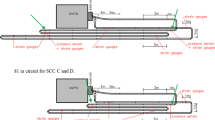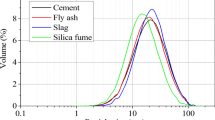Abstract
The main difference between conventional vibrated concrete (CVC) and self-compacting concrete (SCC) is observed in the fresh state, as SCC has a significantly lower yield stress. On the other hand, the placement of SCC by means of pumping is done with the same equipment and following the same practical guidelines developed for CVC. It can be questioned whether the flow behaviour in pipes of SCC is different and whether the developed practical guidelines can still be applied. This paper describes the results of full-scale pumping tests carried out on several SCC mixtures. It shows primarily that the slump or yield stress of the concrete is no longer a dominating factor for SCC, as it is for CVC. Instead, the pressure losses are well related to the viscosity and the V-funnel flow time of SCC. Secondly, bends cause an additional pressure loss for SCC, which is in contrast to the observations of Kaplan and Chapdelaine and the estimation of the practical guidelines is not always on the safe side. Finally, due to the specific mix design of SCC, blocking is less likely to occur during pumping operations, but the same rules as for CVC must be applied during start-up.

















Similar content being viewed by others
References
Ozawa K, Maekawa K, Kunishima M, Okamura H (1989) High-performance concrete based on the durability design of concrete structures. Proc 2nd East Asia: Pacific Conference on Structural Engineering and Construction, Chiang Mae, Vol. 1, pp 445–456
Wallevik JE (2003) Rheology of particle suspensions,.Ph-D dissertation, The Norwegian University of Science and Technology, Trondheim
Crepas RA (1997) Pumping concrete, techniques and applications, 3rd edn. Crepas and Associates, Inc., Elmhurst
Guptill NR et al (1998) (ACI-Comm 304), Placing concrete by pumping methods. American Concrete Institute, Farmington Hills
Spiratos N, Pagé M, Mailvaganam N, Malhotra VM, Jolicoeur C (2003) Superplasticizers for Concrete: fundamentals, technology, and practice, Ottawa
Kaplan D (2001) Pumping of concretes. PhD dissertation, Laboratoire Central des Ponts et Chaussées, Paris
Chapdelaine F (2007) Fundamental and practical study on the pumping of concrete. PhD dissertation , Université Laval, Québec
Tattersall GH, Banfill PFG (1983) The rheology of fresh concrete. Pitman, London
Wallevik OH (2003) Rheology: a scientific approach to develop self-compacting concrete. Proc 3rd Int Symp on Self-Compacting Concrete, Reykjavik, pp 23–31
Roussel N (2006) A thixotropy model for fresh fluid concretes: theory, validation and applications. Cem. Conc. Res. 36:1797–1806
Wallevik JE (2009) Rheological properties of cement paste: thixotropic behavior and structural breakdown. Cem Concr Res 39:14–29
Cyr M, Legrand C, Mouret M (2000) Study of the shear thickening effect of superplasticizers on the rheological behaviour of cement pastes containing or not mineral additives. Cem. Conc. Res. 30:1477–1483
De Larrard F, Ferraris CF, Sedran T (1998) Fresh concrete: a Herschel-Bulkley material. Mat Struct 31:494–498
Feys D, Verhoeven R, De Schutter G (2008) Fresh self compacting concrete: a shear thickening material. Cem Concr Res 38:920–929
Heirman G, Vandewalle L, Van Gemert D, Wallevik OH (2008) Integration approach of the Couette inverse problem of powder type self-compacting concrete in a wide-gap concentric cylinder rheometer. J Non-Newtonian Fluid Mech 150:93–103
Yahia A, Khayat KH (2001) Analytical models for estimating yield stress of high-performance pseudoplastic grout. Cem Concr Res 31:731–738
Feys D, Verhoeven R, De Schutter G (2009) Why is fresh self-compacting concrete shear thickening? Cem Concr Res 39:510–523
Browne RD, Bamforth PB (1977) Tests to establish concrete pumpability. ACI-J 74:193–203
Ede AN (1957) The resistance of concrete pumped through pipelines. Mag Concr Res 9:129–140
Yammine J, Chaouche M, Guerinet M, Moranville M, Roussel N (2008) From ordinary rheology concrete to self compacting concrete: a transition between frictional and hydrodynamic interactions. Cem Concr Res 38:890–896
ASTM C 33 (2003) Standard specification for concrete aggregates. American Society for Testing and Materials, Philadelphia
Jolin M, Burns D, Bissonnette B, Gagnon F, Bolduc L-S (2009) Understanding the pumpability of concrete. Proc 11th Conf Shotcrete Underground Support, Davos
Kasami H, Ikeda T, Yamane S (1979) On workability and pumpability of superplasticized concrete. Proc 1st CANMET/ACI Conf Superplasticizers in Concrete, Ottawa, pp 67–86
Sakuta M, Kasanu I, Yamane S, Sakamoto A (1989) Pumpability of fresh concrete. Takenaka Technical Research Laboratory, Tokyo
Schwing (1983) In: Eckardstein KEV (ed) Pumping, concrete and concrete pumps: a concrete placing manual, p 133
De Schutter G, Bartos P, Domone P, Gibbs J (2008) Self-compacting concrete. Whittles Publishing, Caithness
Kaplan D, de Larrard F, Sedran T (2005) Avoidance of blockages in concrete pumping process. ACI Mat J 102–3:183–191
Jacobsen S, Haugan L, Hammer TA, Kalogiannidis E (2009) Flow conditions of fresh mortar and concrete in different pipes. Cem Concr Res 39:997–1006
Rössig M (1974) Pumping of fresh concrete, in particular lightweight concrete, through pipes. PhD dissertation, RWTH Aachen, Westdeutscher, Opladen, p 224
Chalimo T, Touloupov N, Markovskiy M (1989), Pecularities of concrete pumping (in Russian). Minsk
Morinaga M (1973) Pumpability of concrete and pumping pressure in pipeline. Proc RILEM Seminar on Fresh Concrete: Important Properties and their Measurement, Vol 7, Leeds, pp 1–39
Thrane LN (2007) Form filling with SCC. PhD dissertation, Technical University of Denmark, Denmark
Ngo TT (2009) Influence of concrete composition on pumping parameters and validation of a prediction model for the viscous constant. Ph-D dissertation, University Cergy-Pontoise
Feys D (2009) Interactions between rheological properties and pumping of self-compacting concrete. PhD dissertation, Ghent University, Ghent
Feys D, Heirman G, De Schutter G, Verhoeven R, Vandewalle L, Van Gemert D (2007) Comparison of two concrete rheometers for shear thickening behaviour of SCC. Proc. 5th Int RILEM Symp on SCC, Ghent, p 365–370
Macosko CW (1994) Rheology principle, measurements and applications. Wiley-VCH, New-York
Poiseuille JLM (1840) Recherches expérimentales sur le mouvement des liquides dans les tubes de très-petits diamètres. CR Acad Sci Paris 11:961–967, 1041–1049
Poiseuille JLM (1841) Recherches expérimentales sur le mouvement des liquides dans les tubes de très-petits diamèters. CR Acad Sci Paris 12:112–115
Buckingham E (1921) On plastic flow through capillary tubes. Proc. Am. Soc. Testing Mat. 21:1154–1161
Feys D, Verhoeven R, De Schutter G (2008) Extension of the Poiseuille formula for shear thickening materials and application to self compacting concrete. Appl Rheol 18(6):62705
Jacobsen S, Vikan H, Haugan L (2010) Flow of SCC along surfaces. Proc 6th Int RILEM Symp Design, Prod Placement SCC, Montréal, Vol I, pp 63–174
Jodeh SA, Nassar GE (2009) Pumpability assessment of C90 SCC. Proc 2nd Int Conf Adv Concr Technol Middle-East: Self-Consolid Concr, Abu Dhabi, pp 155–176
Acknowledgments
The authors would like to acknowledge the Research Foundation in Flanders, Belgium (FWO) for the financial support of the project and the technical staff of both the Magnel and Hydraulics laboratory for the preparation and execution of the full-scale pumping tests.
Author information
Authors and Affiliations
Corresponding author
Rights and permissions
About this article
Cite this article
Feys, D., De Schutter, G. & Verhoeven, R. Parameters influencing pressure during pumping of self-compacting concrete. Mater Struct 46, 533–555 (2013). https://doi.org/10.1617/s11527-012-9912-4
Received:
Accepted:
Published:
Issue Date:
DOI: https://doi.org/10.1617/s11527-012-9912-4




